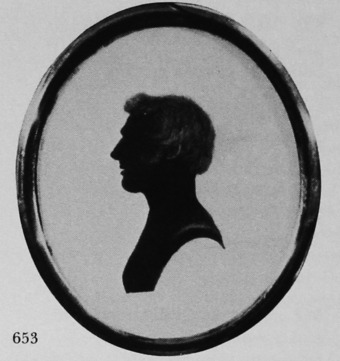Alcock (McKechnie Section 2)
Known from four silhouettes, three dated 1816 and one (of a William Lynn)1817.
Foskett records a Mrs Easthead, née Harriet Alcock, who exhibited at the Royal Academy in 1832 (as Miss Alcock) and in 1835 (as Mrs Easthead, spelt 'Easthed' in the original Royal Academy catalogue). Before her marriage she lived in the Herne Hill district; after her marriage, in Dulwich. She may have been the daughter of the silhouette artist, who may, in that case, have lived in Herne Hill. As the silhouettes are simply signed 'Alcock', it seems unlikely that the artist was a woman, and Harriet herself would probably have been too young to be capable of work of this quality as early as 1816-17. Graves lists a J. Alcock who exhibited an architectural subject at the Royal Academy in 1821 and may have previously painted silhouettes.
One silhouette (not illustrated) is painted in gold against black; the others (including the silhouette of William Lynn) are painted in gold and/or yellow and orange pigment against a background of dull sepia body colour. Gum arabic is used to indicate deep shadow. Where gold only is used, the work slightly resembles that of Edward Foster, but the brushwork is coarser.
Two examples of Alcock's work are illustrated. The one in my collection is painted in the neo-classical style. It has a bust-line finish which is quite different from that of the other illustrated silhouette, closely resembling that of the silhouette. referred to above, painted in gold against black: there is a low plunge in front, terminated with a squared-off finish. The other illustrated profile is finished with a sloping convexity-concavity curve, similar to that on the silhouette of William Lynn.
Despite the differences in style, all four silhouettes are by the same hand. All except the example painted in gold against black (which is housed in a red leather pocket case) are in papier mâché frames.
The two illustrated examples are signed on the reverse (see captions). The other two examples are signed beneath the bust-line, 'Alcock. 1816' and 'Alcock, 1817' respectively.
Ills. 652, 653

Samuel Jackson
Silhouette painted on card in yellow and orange against a mid-brown background
1816
3 x 2½in./77 x 64mm.
Frame: papier mâché
Inscribed ‘1816’ below the bust-line.
‘Alcock fecit, 1816’, on the reverse.
Elliott Levy collection

Unknown man
Silhouette painted on card in gold and gum Arabic against a reddish-brown base colour
1816
3 3/8 x 2¾in./86 x 70m.
Frame: papier mâché
Painted in the neoclassical style
Signed ‘Alcock 1816’ on the reverse, in pencil.
Author’s collection
